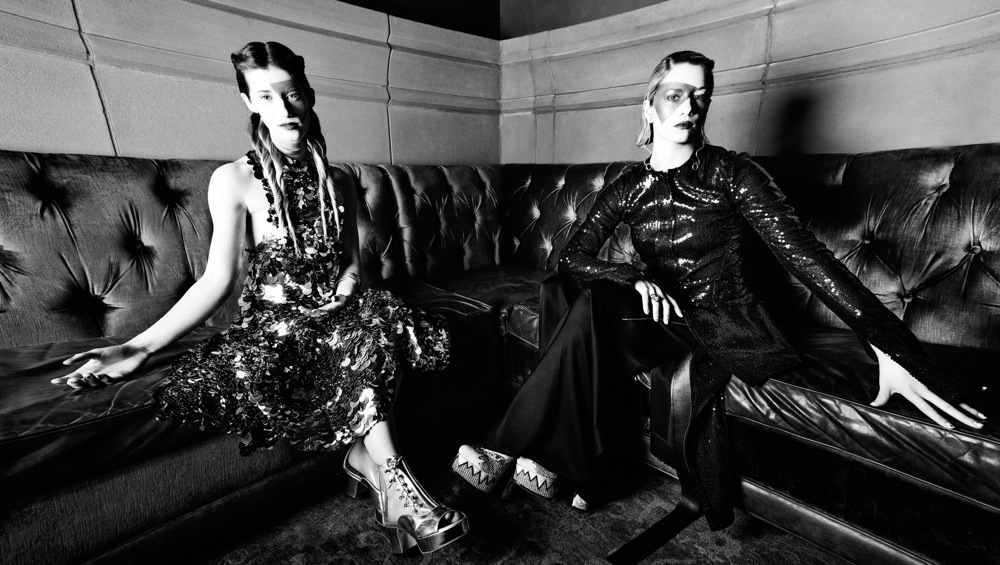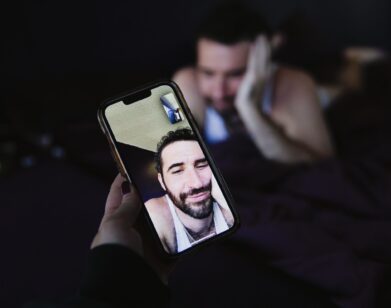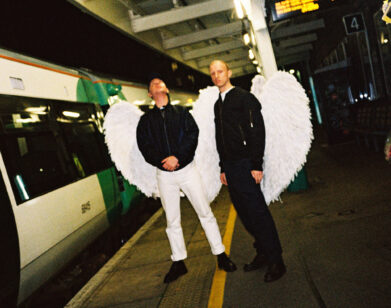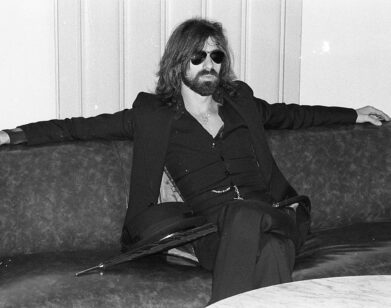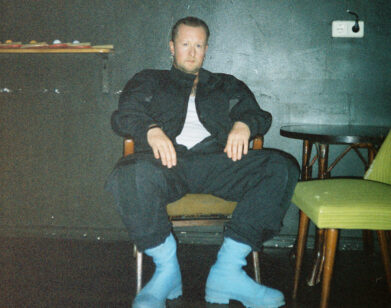Prince Rama’s State of Being
PRINCE RAMA (TARAKA AND NIMAI LARSON) IN NEW YORK, FEBRUARY 2016. PHOTOS: DAEMIAN SMITH + CHRISTINE SAUREZ. STYLNG: NINA STERGHIOU/BRIDGE ARTISTS. HAIR: HOLLY MILLS AT TIM HOWARD MANAGEMENT. MAKEUP: KAJSA SVANBERG AT ART DEPARTMENT USING DIOR ADDICT. MANICURE: YUKIE MIYAKAWA AT KATE RYAN INC FOR DIOR VERNIS. SPECIAL THANKS: SOHO GRAND HOTEL.
With a name that hails from an ancient Sanskrit poem, the spiritual leanings of Brooklyn-based, electro-dance duo Prince Rama are unsurprising, but their latest album Xtreme Now (released last month via Carpark Records) takes its cue from a much more unlikely source: extreme sports. Though the sisters Nimai and Taraka Larson admit to excessively viewing GoPro videos, the LP is built upon the notion of occupying a state of “extreme now,” which began when Taraka’s former college professor invited her and Nimai to Vormsi, an island off of the coast of Estonia, where he was making a pseudo-black metal utopian film.
Taraka’s immediate reply was “fuck yeah,” and the sisters moved to a commune on the island during the summer of 2012. While there, Taraka had a near-death experience in a Viking ruin, resulting in a vision involving extreme sports, the future of museums, and the Middle Ages. The experience is surreal and nearly unreadable when condensed to its basic descriptors, but its influence on Prince Rama’s music and the duo’s outlook on life is concrete.
“There’s something about that space of near-death [where] you are at your most alive, your most pure and honest,” Taraka recalls. “When most people walk around, they don’t realize [their] fear of death, on a day to day basis—even [in] very small ways, like going to the store and buying anti-wrinkle cream, is expressing a fear of death, growing older, and time. The thing with extreme sports is there’s this acceptance and respect of death,” she continues. “As soon as you can detach yourself from that fear, you also are detaching yourself from time; you’re living in this space beyond time, in this state of pure being.”
We spoke with Taraka over the phone on a day off from tour (which arrives in Brooklyn at Rough Trade this Wednesday, April 20), about Prince Rama’s experience in Estonia, the duo’s glittering aesthetic, and their early years spent on a Hare Krishna farm in Florida.
HALEY WEISS: Where are you now?
TARAKA LARSON: Good question, I have to ask myself that question every morning. We’re in Indianapolis. We just got in a studio and we’re laying down some tracks on our day off.
WEISS: Where do you feel most at home, when you’re on tour or when you’re in Brooklyn? I read what you wrote about the “Now Age” and it seems like being in a constant state of movement and on tour would be closer to the utopia you described.
LARSON: I feel like utopia is neither here nor there. It’s in that sort of space where you feel the most present, and that can be on tour [or] at home. It’s easier to get to that place on tour because your environment is constantly changing, and from a very primal, evolutionary perspective, you have heightened awareness when you’re in an unfamiliar place, so it’s easier to access that state.
One of the reasons why I chose to live in New York was that there is this sense of your environment constantly changing. I still feel that tour energy when I’m there; you can go day-to-day and feel like you’re in a completely different city depending on what part of town you’re in. But again, it’s not really where you are, it’s where your head is. As soon as you can access that state of presence, that state of calm presence, you feel the most at home, because that’s your most natural state, I think.
WEISS: When did you start watching GoPro extreme sports videos and decide that they needed a soundtrack?
LARSON: Basically, I had this crazy, a bit of a near-death experience in Estonia. I had these visions of the future but I was in this state where I felt the past, the present, and the future were all happening at the same time. I had this vision of these museums merging with extreme sports and I didn’t really know much about extreme sports at the time, so after having this vision I got really curious like, “Okay, what’s the deal with extreme sports?” I started obsessively watching GoPro videos after that.
WEISS: Did you try any extreme sports?
LARSON: Oh yes, I tried as many as I could. I failed miserably but I gave it an honest effort. What it made me realize was I was going about it all in the wrong way; I was trying to do them but there’s so much more to extreme sports than the actual physical [act]. There’s this metaphysical mental process you have to put yourself through to be in that state of “extreme now,” where you’re in this extreme presence and total fearlessness, total trust. I was trying to conquer these sports but the sports are just the icing on the cake. The act of doing them is actually the byproduct of this extreme state of presence. I got a lot more interested in approaching that and starting from the basics, and really starting to live my life applying this extreme sports mindset to everything. Hopefully, with some years of practice and just getting to that state, I’ll try extreme sports again.
WEISS: What was the particular near-death experience you had in Vormsi?
LARSON: It’s bizarre to talk about these kinds of experiences because I feel like the translation of them takes something away from them a little bit. I had this experience where I was riding my bike around the island and I was drawn to this mound of grass, for no reason at all, so I walked over there and saw that the mound had this doorway and you could go inside. It was actually an interred Viking ruin. I went inside and immediately the temperature completely shifted; I had full body tremors and almost felt hypothermic—I’ve had hypothermia before and that’s the only thing I can liken it to—and I felt my consciousness dislocate from my body. In this very trance like state, I was able to experience space and time from beyond time. I felt everything become very gooey, like putty, and I could just reach out and touch the Middle Ages like it was sitting right across the dinner table from me, or touch the future, it was just right there.
I was also experiencing a lot of audio hallucinations, like music played by instruments [that] I can’t even fathom. It didn’t sound like instruments that were made by human hands. Everything was very synesthetic and interconnected. I felt like the music was something you could taste or smell, or if I thought a certain thought, the music changed with [my] thought pattern, and it would change with the images I was seeing too. The sort of imagery I was seeing was these visions of museums, you could say, but museums that were fused together with the X Games. There would be these unicorn tapestries stretched across half-pipes and people doing 360s off of them, and people kept base jumping off of planes and cliffs wearing Mona Lisa costumes. It was really insane and inspiring.
I really wanted to be able to make the music that acknowledged the metaphysical aspect of extreme sports because when I started watching GoPro videos, the thing that struck me the most was that the sound seemed completely detached from the imagery. These people are risking their lives and there’s dumb dubstep playing—it’s so anti-climatic. I really feel like there’s a void in this world for music that acknowledges that spiritual aspect of these activities as well as just the sheer physicality of them.
WEISS: How soon after having that experience were you able to translate it into music?
LARSON: I had writers block for months afterwards because I was just so taken aback by all of the sounds I was hearing. It’s almost like hearing the most beautiful music you’ve ever heard, so you’re like, “What’s the point of me making anything?” It was this living sonic organism so the idea of recording something just seemed like taking this living thing and mummifying it.
Nimai and I are very psychically connected to each other, I guess just being sisters, so as soon as we started watching sports videos we thought, “Oh yeah, we could totally get into this zone.” I think it really started by watching them a lot and jamming on top of them… Also, just trying to remember the spirit of that sonic organism that I was listening to in the Viking ruin, instead of trying to replicate it, realizing that sound comes from a state of being in this extreme presence. As soon as I could put myself in that trance-like state I felt the music flowed very freely.
WEISS: I want to talk a bit about your aesthetic, because you incorporate patterns, bright colors, glitter, and the Mona Lisa in your performances. How core is that appearance to your music? Do you consider it to be essential or a separate choice?
LARSON: The most essential part is the music. Everything else is the icing on the cake. But, I always look at that stuff as something that’s not a separate entity from the music but a visual representation of the music. I feel like your external appearance should be in harmony with your internal appearance. That’s mainly our approach to the visuals. It’s not a super conscious decision, all of these different things, it’s more letting the music speak for what our appearance should look like; it’s how the music wants to represent itself through us.
WEISS: Was it clear since you were young that music would be a collaboration between you and your sister?
LARSON: We’ve always been close collaborators, even when we were growing up and putting on little puppet shows using whatever we had lying around the house. I remember at one point we just took my mom’s feet—she was just laying down on the couch—and we were just drawing on them with sharpies and making little puppet shows. Whatever we had we would try to make little shows or performances happen. I think it’s very natural. We grew up in the middle of fucking nowhere, Texas, and we weren’t really allowed to watch TV or do anything like that. We had to keep ourselves entertained somehow and I think we still have that mentality.
We wanted to start making music together because we were obsessed with Hanson growing up and thought that they were the coolest brothers ever and maybe if we started a band we could marry them someday. [laughs] There are a lot of unspoken things with me and Nimai. We’re very yin and yang, neither one of us really treads on each other’s toes. She’s this wizard of the rhythm world, and I know nothing about that, but I can dabble with melody and lyrics and that’s something she doesn’t really have any interest in. We complement each other in that way.
WEISS: I know you spent time in high school on a Hare Krishna farm in Gainesville, Florida with your family. Can you tell me a bit about how that has informed your spirituality or outlook on life?
LARSON: My parents both renounced their material lives and were living as monks at an ashram in L.A. when they met each other. So we were always raised in this environment and when we moved to the ashram in Florida it was just like, “Oh, wow, now all of a sudden there’s more people like us,” because we were growing up in the middle of Texas with our parents, always being the weirdos. When we moved to Florida we experienced it on a communal level, in a more structured religious setting, with temples and different worships. That sense of community is very much interconnected with music for us, and thinking of music as this living organism that offers a space of mystical participation with forces outside yourself.
The way that music is approached in the temple is very call and response; it breaks down that barrier between performer and audience. There’s the person that’s calling and the person that’s responding, and this other entity that’s responding to both sides, which is really special. I feel like with our shows it always feels weird to be performers on stage and not engaging in audience interaction in some way—that exchange of energy is very much a part of the sound.
We listened to hardly any music except Hare Krishna music growing up and the occasional Garth Brooks that our babysitter would play for us. From a very early age, we looked at music as mantra based, very cyclical, and having no linear time. If you repeat something enough it can literally physically change the air particles around you and it can infuse the air with this sacred sound vibration, or it can change your material body, like transform your flesh to spirit. These are all beliefs within the Hare Krishna philosophy we were brought up with. When we did start listening to pop music and became more interested in pop, it was coming from this context of mantra and cyclical music. I know people within the Hare Krishna community look at pop music as secular, different, and something separate from spiritual music but for me, there’s no difference. I listen to pop music and it sounds like mantra to me, there’s this power to it. There’s also something to be said about how it reaches people on a mass level, there’s some magic to that.
PRINCE RAMA WILL PLAY AT ROUGH TRADE IN BROOKLYN ON WEDNESDAY, APRIL 20, AND XTREME NOW IS OUT NOW. FOR MORE, VISIT PRINCE RAMA’S WEBSITE.

